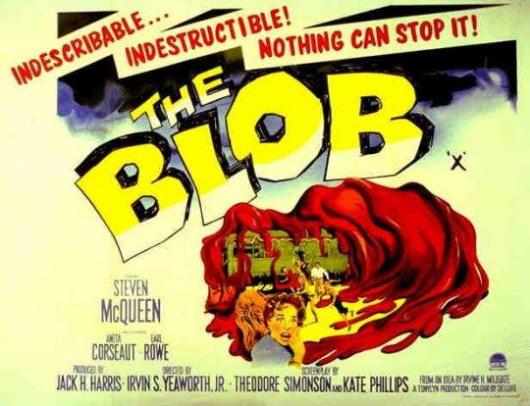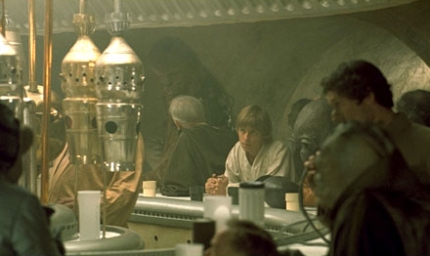Some of my favorite things about the holidays (besides all-you-can-eat dinner rolls and hanging out with my labradors) are movie marathons on TV. While I own most of the movies on the marathon lineups, they’re just so much better when you know the rest of the world is enjoying them. They become events; I guess the same kind of community that you get in a theater is felt when you can go on twitter and see that the rest of the world is also enjoying #HarryPotter. This Thanksgiving, I happened to catch the last part of The Godfather and slowed down for a few minutes to watch it. The scene in the garden grabbed my interest in particular; while I have seen bits and pieces of The Godfather for years, I’ve never really appreciated this scene for what it is. After taking this class, I found myself analyzing the scene. As an artist, I was amazed at the attention paid to scenic composition and as a bored twenty-two year old, I was impressed with the range of emotion the scene made me feel.
The scene starts with the grizzly Don Corleone entertaining his grandson in a garden. At first, he seems a little irritated with the boy as he tries to show him how to use a watering can. The child is totally oblivious to The Godfather’s frustration, which sets the tone of childhood innocence that remains throughout the scene. To entertain the child. Don Corleone puts an orange peel in his mouth. At first, this scares the kid; Don Corleone, in his rough, intimidating manner, realized that he has to become softer in order to interact with someone so innocent. His frustration dissolves as he allows Anthony to chase him around the garden with the watering can. Taken completely out of context, this is an adorable scene between a grandfather and his grandson. When we know the atrocious and intense life that Don Corleone has led, however, the innocence of Anthony takes on a much deeper meaning. While chasing Anthony around, Don Corleone slumps over of a heart attack in a dramatic, grasping scene. The child has absolutely no idea what’s going on– despite the fact that Don Corleone is now laying completely motionless on the ground, Anthony continues to spray him with the can. Eventually, Anthony runs off, and the scene dissolves into a funeral. You hear the first toll of the funeral bell while still seeing the visual of the garden in a seamless transition to the business side of death.
There’s something beyond the obvious soft side of Don Corleone that you see in his death scene. The lighting and color in the scene, for one, bring to mind the Garden of Eden of a traditional view of heaven. Despite the fact that the mafia is ruled in tones of cold black and sharp grey, Don Corleone’s end doesn’t come in the form of a bullet— it comes in the form of bright yellows and happy greens. The colors invokes the innocence the rest of the movie doesn’t– it’s as though this particular scene (which calls back images of the green homeland, Sicily) is dripping in complete innocence. Without this innocence, might Don Corleone have survived? If his grandson knew he was having a heart attack, could he have been saved? Probably, but it wouldn’t be as satisfying as Don Corleone, a dark character who we have grown to love, dying in a moment so far from the intense, threatening opening wedding scene. As the bell tolls and the scene ends, we are transported to a world of stark black business suits that contrast with the floral arrangement that covers Don Corleone’s casket. It’s a beautiful moment as we realize that Don Corleone is no longer part of this world of harsh lines and business. He is immortalized in the religious imagery that has cloaked his sinful world; as Michael becomes both the literal and figurative godfather in the baptismal scene that follows the funeral, we are again greeted with a contrast of innocence and power in a cathedral that brings to mind a grand coronation. The transition from the death scene to the funeral scene is particularly powerful to me as we see Michael picking up his father’s torch. The family is grieving when a dark, shadowy figure enters the scene and asks Michael for a word. Momentarily, we believe Michael might deny the invitation to discuss mob business at a funeral, but he instead stands up into the shadow where the entire tone of the scene becomes more like an office than a sunny day.
Don Corleone’s death scene is more than just a scene in a movie; it’s a moment where the audience can appreciate the childlike wonder that humans still have when it comes to death. In his last moment, Don Corleone was likely thinking of nothing more than how to entertain Anthony. Death struck him, in a weird existentialist way, when his guard was completely let down. He spent his entire life watching out for the enemy, but in the end was brought down by simple play. As he dies this beautiful, anticlimactic death, we briefly wonder why Michael is so concerned with the mob still despite the futility of it all. The ceremonial pomp and circumstance that surround both the funeral and the baptism are pointless when contrasted to the almost frivolous garden scene. In this moment, Francis Ford Coppola teaches us to slow down and stay in the light. The second Michael steps into the shadow, his choice is made. How can we, as people in a work-driven society, learn to stay in the light?
Of course, this all may be over-interpretation or I may just be missing the entire point. But that’s okay, because this scene made me think about my own life and the way I approach things. Isn’t that the point of good art? Almost every interpretation of anything ever could be seen as pointless. Film, in particular, is a medium that is especially open to interpretation; because there are so many layers of meaning and mediums of expression interacting with one another within the context of a film, it’s hard to pinpoint the director’s intentions in every moment. I will concede that before this semester, I thought directing must be a really easy job. You just tell the actors where to go! It can’t be that difficult. The real strength is in the writing, right? Now, I understand that there are so many ways to express concepts via film that I might never totally understand what’s going on in a well-directed scene. Before, watching movies wasn’t really something I found entertaining. But now I’m noticing little things all the time (like the fact that Francis Ford Coppola is an absolute master when it comes to composition). Filmmaking is now a talent I have much more respect for. Film is one of the greatest ways to express our fears and passions as a nation. Like I wrote in my last post, I believe that film and the study of it creates better citizens of a global society. It may be a long shot, but I think the understanding that comes with good film could solve more than a few big societal problems.
Just don’t go all Richard Nixon and invade Cambodia after watching Patton.



